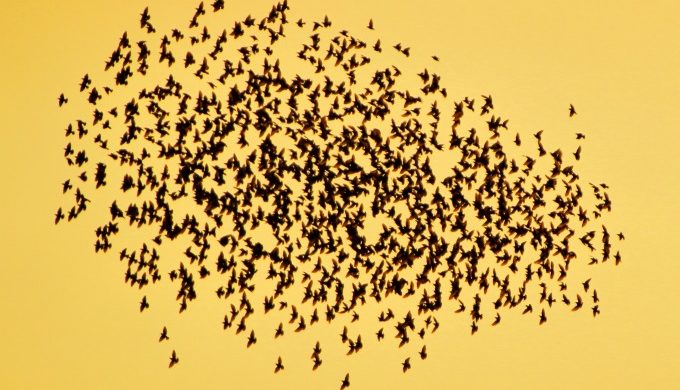This time of the year, it’s not uncommon to look up in the sky and see what appears to be a “bird tornado”…swirling black blobs of birds, twisting and turning in synchronization in the sky. What on earth is happening here? What you’re witnessing are starling murmurations and they are common occurrences in the fall.
No one quite knows why starlings murmurate and scientists aren’t even sure how they do it, either. Complex algorithmic models haven’t yet explained the starlings’ aerobatics, which rely on the tiny bird’s quicksilver reaction time of under 100 milliseconds to avoid aerial collisions—and predators—in the giant flock. So while scientists struggle to figure out how the birds do this, they have some ideas as to why the murmurate.
Photo: Wikimedia Commons
One theory as to why starlings do this is based on the fact that often the behavior is sparked by the presence of a predator like a hawk or peregrine falcon, and the flock’s movement is based on evasive maneuvers. There is safety in numbers, so the individual starlings do not scatter, but rather are able to move as an intelligent cloud, moving away from a diving raptor–thousands of birds changing direction almost simultaneously. The question that has had scientists stumped is how a bird, tens or hundreds of birds away from those nearest danger, sense the shift and move in unison?
Movement Affected by Seven Closest Neighbors
Photo: Wikimedia Commons
Scientists have attempted to apply equations and formulas to figure out the movements within a murmuration and this is one of the findings: In 2012, a team published research showing that each bird is actually reacting to the birds nearest to it–that the movement is the result of a series of short-range reactions. In previous studies, the team looked at velocity; this time they studied orientation. Measuring how a change in direction by one bird affects those around it, the team discovered that one bird’s movement only affects its seven closest neighbors. So one bird affects its seven closest neighbors, and each of those neighbors’ movements affects their closest seven neighbors and on through the flock. This is how a flock is able to look like a twisting, morphing cloud with some parts moving in one direction at one speed and other parts moving in another direction and at another speed.
Starlings Are a Non-Native, Invasive Species
Photo: Flickr.com
There are 200 million starlings on the continent, and they can be found as far north as Alaska and as far south as Mexico. Numerous though they are, starlings are actually a non-native invasive species. In fact, starlings are one of the few birds that are not protected under state and federal law as indicated by the Texas Parks and Wildlife, so wildlife enthusiasts have been known to kill the birds.






